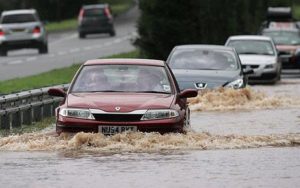
While many cars will get through quit severe floods, there are a number of dangers. In addition to shorted-out electrics, there is a risk of the engine sucking in water which, being incompressible, will smash connecting rods, pistons and even crankshafts. If the water is fast-moving, there is also a risk that the car could be carried off into deeper flood water with you inside.
So what should you do when you meet a flood?
First things first, you should try to avoid it, but if you can’t, you should make sure there is not more than six inches of standing water or four inches of moving water. Parking up and watching other cars and trucks negotiate the flood can be a good way of checking to see how deep it is. In particular look out for hidden dips and gullies where the water could suddenly get deeper.
If you decide to go through, stay on the crown of the road where possible and crawl through the water very slowly in first gear. Keep the engine revs up (by slipping the clutch if necessary) to avoid water entering the exhaust pipe. Also avoid the temptation to make a quick exit, as going at speed can push water into the engine.
Even drivers of large 4x4s should take care. Experts at Land Rover advise entering the water slowly (about 1-2mph), before accelerating to about 3-4mph. This creates a bow wave in front of the vehicle, which will create a depression in the engine bay and keep the air intake clear of water. However, this technique won’t work with old, beam-axled 4x4s, as the water tends to hit the front axle beam and squirt straight into the engine bay.
Avoid going too fast into even quite shallow puddles as that can lead to aquaplaning, where the front tyres will no longer steer the car and you lose control. It is also inconsiderate and illegal to soak pedestrians.
When you emerge from the water, dry the brakes by using them gently, and if there were leaves in the water, check the radiator for blockages.
Another thing to watch out for is the lunatics coming the other way. You might be observing all the best advice, but big 4x4s or trucks racing though in the opposite direction can create such bow waves they drown your car.
If the worst happens and your car stops, leave the bonnet closed to avoid any further water ingress, climb out, lock the car and wade to dry land. In direst emergencies, you could try winding the car out by operating the starter in first or reverse gear but few starter motors will stand that sort of punishment so don’t rely on it.
